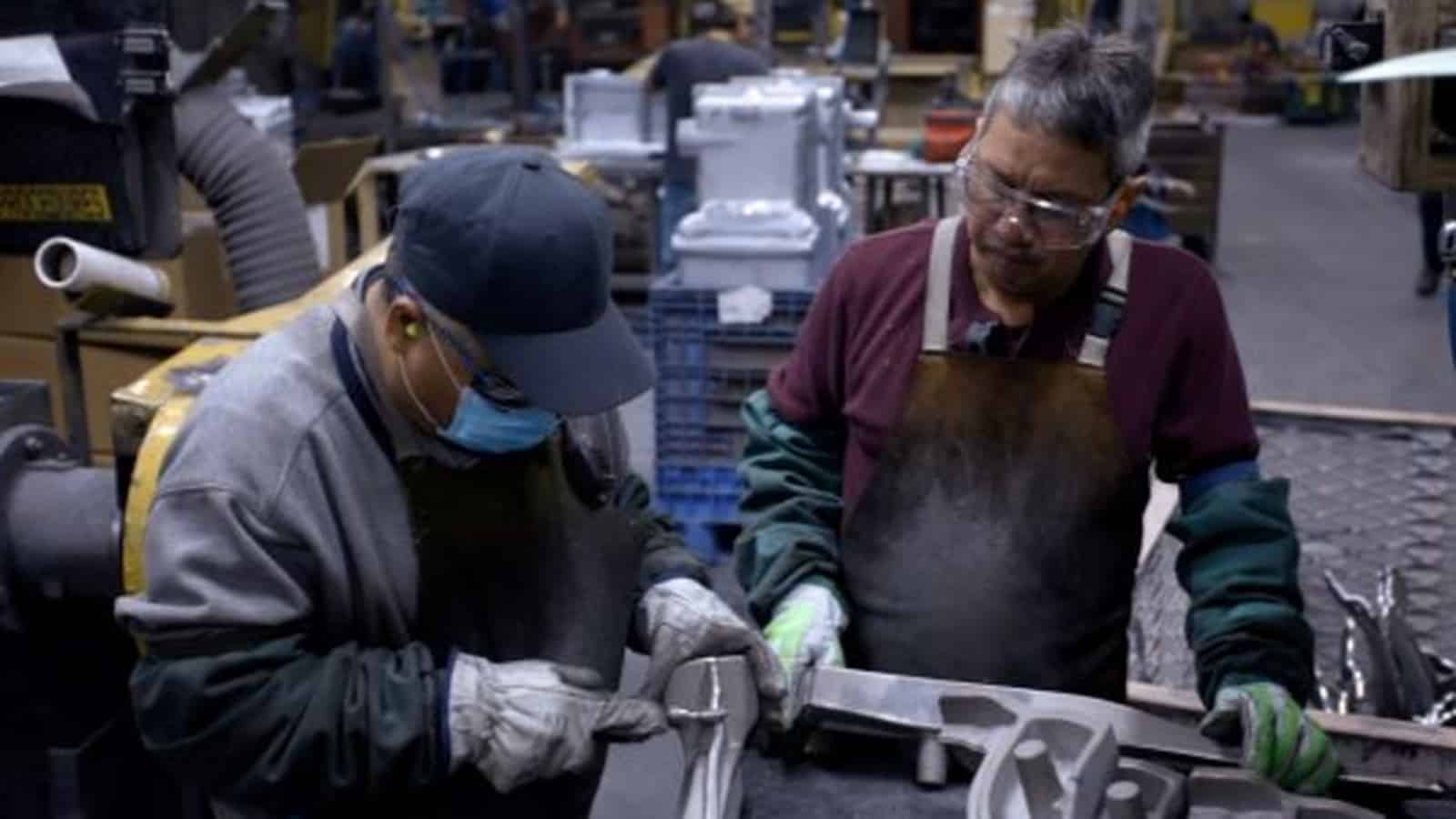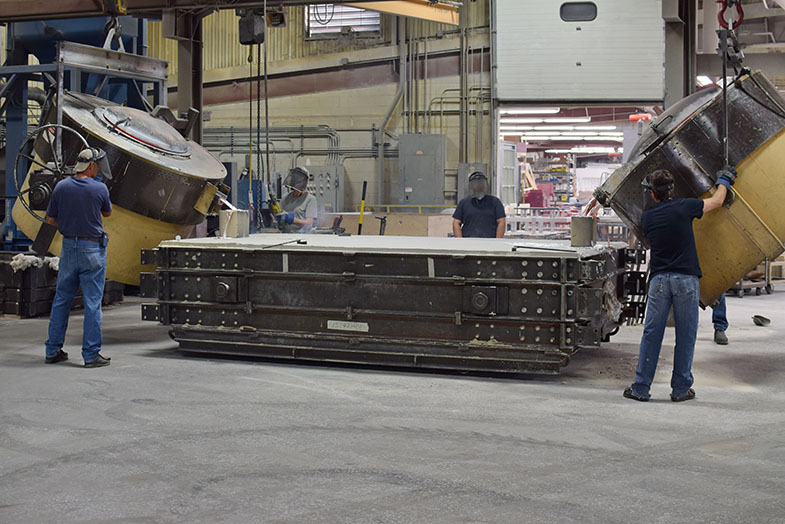Recognizing the Importance of Aluminum Foundry in the Aerospace and Automotive Industries
Aluminum foundries are important to the aerospace and auto sectors. They offer necessary light-weight parts that add to general efficiency and performance. The unique homes of aluminum deal distinct advantages in production. As innovations in modern technology and lasting techniques arise, the duty of these foundries is evolving. Recognizing these variables elevates essential inquiries concerning the future of transport and development. What ramifications do these advancements hold for the industries at large?
The Duty of Aluminum Foundries in Production Lightweight Elements
Aluminum foundries play an essential role in the aerospace and automobile sectors by creating light-weight elements that improve efficiency and gas effectiveness. The demand for lighter materials has actually surged as producers look for to lower general car weight, resulting in improved gas economic climate and reduced exhausts. Aluminum's unique residential or commercial properties, including high strength-to-weight proportion and rust resistance, make it an excellent option for various applications.
Components such as engine blocks, transmission housings, and structural elements benefit from aluminum's malleability and simplicity of casting, providing the needed strength while decreasing weight. Furthermore, aluminum's recyclability lines up with lasting manufacturing techniques, additionally driving its fostering in these sectors. Shops use accurate strategies to guarantee excellent material buildings, promoting advancements in style and innovation. Eventually, aluminum foundries are necessary in meeting the advancing needs of aerospace and automobile sectors, adding to improvements in security, performance, and environmental obligation.
Advanced Casting Techniques Utilized in Aerospace and Automotive Applications
In the aerospace and automobile markets, progressed casting strategies have actually become essential for improving performance and performance. Accuracy spreading methods, in addition to lightweight alloy technologies, make it possible for the production of components that satisfy rigorous sector standards. In addition, the assimilation of additive production further transforms design opportunities, enabling higher customization and intricacy partly.
Precision Casting Approaches
While industries such as aerospace and automobile progressively need high-performance components, accuracy casting approaches have become crucial methods to satisfy these demands. These techniques, including investment casting and pass away spreading, offer phenomenal dimensional precision and surface coating, important for elements subjected to extensive operational problems - Aluminum Foundry. Investment casting enables elaborate designs and intricate geometries, making it possible for the production of lightweight yet durable components. Die casting, on the various other hand, guarantees high volume manufacturing with constant quality and lowered preparations. Both techniques help with the effective use products, lessening waste and improving sustainability in manufacturing procedures. As the demand for innovative services remains to expand, precision spreading techniques play an essential function in advancing the abilities of aluminum foundries within these crucial industries
Light-weight Alloy Advancements
As the aerospace and automotive sectors go for boosted performance and effectiveness, technologies in lightweight alloys have actually ended up being increasingly significant. These alloys, that include advanced aluminum-lithium and magnesium-based structures, offer remarkable strength-to-weight proportions, allowing producers to generate elements that are both durable and lightweight. The fostering of these materials not just enhances fuel efficiency yet additionally minimizes greenhouse gas emissions, lining up with international sustainability goals. Advanced casting methods, such as die casting and financial investment spreading, have been maximized to deal with these light-weight alloys, enabling elaborate styles and complex geometries. This adaptability boosts the capability and performance of components used in vital applications, from airplane structures to automotive structures, solidifying the role of aluminum foundries in driving market technology.
Additive Production Integration
Additive manufacturing has become a transformative force in the aerospace and automobile fields, flawlessly incorporating with advanced spreading methods to enhance manufacturing capacities. This combination permits the creation of intricate geometries that traditional methods struggle to achieve, significantly enhancing style flexibility. By combining additive processes with aluminum spreading, suppliers can maximize weight decrease while keeping architectural stability. This synergy likewise fosters fast prototyping, enabling quicker models and reducing time-to-market for new parts. Furthermore, using additive manufacturing can reduce product waste, straightening with sustainability goals in both industries. Consequently, the partnership in between these advanced strategies is leading the way for cutting-edge remedies and efficiencies that redefine manufacturing in aerospace and auto applications.
Advantages of Aluminum as a Material in High-Performance Components
Aluminum provides substantial advantages in high-performance parts due to its lightweight framework, which adds to boosted fuel efficiency and boosted performance in both aerospace and automotive applications. In addition, its rust resistance properties assure longevity and resilience, making it an ideal selection for elements revealed to severe environments - Aluminum Foundry. These this content benefits setting aluminum as a leading material in the production of advanced high-performance components
Lightweight Framework Benefits
When considering materials for high-performance components in aerospace and automobile sectors, the lightweight structure of aluminum supplies considerable benefits. Its low thickness permits the development of parts that reduce total lorry weight, enhancing fuel effectiveness and efficiency. This decrease in weight adds to lower discharges and improved functional prices, making aluminum an ecologically pleasant selection. Additionally, lighter structures allow better handling and acceleration, essential aspects in affordable auto racing and progressed aircraft layout. The capacity to develop detailed forms without endangering toughness additionally improves aluminum's appeal, permitting suppliers to introduce while satisfying rigid safety and security criteria. Overall, the lightweight nature of aluminum sustains the market's shift in the direction of extra reliable and high-performing automobiles.
Corrosion Resistance Features
The remarkable deterioration resistance of aluminum makes it an excellent option for high-performance parts in both aerospace and automotive markets. This building is crucial, as elements are typically subjected to extreme environmental problems, consisting of dampness, salt, and severe temperatures. Aluminum's natural oxide layer acts as a safety barrier, protecting against the underlying steel from corroding, consequently prolonging the lifespan of crucial components. On top of that, aluminum alloys can be tailored to improve deterioration resistance, permitting for details applications in requiring atmospheres. This strength minimizes maintenance expenses and improves safety, making aluminum a preferred material for components such as engine parts, frameworks, and architectural elements. Ultimately, the deterioration resistance of aluminum contributes significantly to the overall integrity and efficiency of cars and aircraft.
Technologies Driven by Aluminum Foundries
As markets increasingly focus on lightweight products for boosted effectiveness, innovations driven by aluminum foundries have emerged as a crucial force in both aerospace and automobile markets. These foundries go to the forefront of developing sophisticated aluminum alloys and casting methods, which enhance mechanical homes and minimize overall weight. Improved die-casting methods, such as high-pressure die casting and press casting, make it possible for the production of elaborate forms with exceptional surface finishes, resolving complicated design needs.
Additionally, the assimilation of automation and robotics in aluminum foundries has structured production processes, boosting effectiveness and lowering lead times. The adoption of additive manufacturing strategies, including 3D printing with aluminum materials, has actually likewise opened new avenues for fast prototyping and customization. These innovations not just add to the efficiency and durability of components yet additionally boost the style image source flexibility for producers, enabling even more cutting-edge and effective vehicle designs in both aerospace and auto applications.
Ecological Benefits of Using Aluminum in Production
Several products are made use of in production, aluminum stands out for its substantial environmental advantages, particularly in the aerospace and automotive markets. Its lightweight nature contributes to enhanced fuel performance in cars and aircraft, resulting in lowered greenhouse gas exhausts. In addition, aluminum is very recyclable; around 75% of all aluminum ever before created is still in operation today. This recyclability minimizes energy intake, as reusing aluminum requires only 5% of the power required for primary manufacturing.
Aluminum's long lifespan and resistance to rust reduce the demand for constant replacements, consequently lowering waste generation. Making use of aluminum in manufacturing not only sustains lasting methods but additionally aligns with the growing international emphasis on decreasing carbon footprints. As markets undertaking for greener services, including aluminum is a calculated option that fosters environmental obligation while fulfilling the extensive needs of aerospace and automotive applications.

High Quality Control and Testing in Aluminum Foundries
Reliable quality assurance and strenuous testing are important in aluminum foundries to ensure the manufacturing of high-performance parts for aerospace and automobile applications. These processes start with the careful option of resources, ensuring they fulfill particular chemical and physical residential or commercial properties. Shops carry out rigid tracking systems throughout the production procedure, consisting of temperature level control and mold integrity checks, to avoid flaws.
Checking techniques, such as spectrometry and mechanical screening, confirm that the aluminum alloys possess the necessary toughness, ductility, and exhaustion resistance. Non-destructive testing techniques, like ultrasonic and X-ray assessments, are employed to determine interior defects without damaging the components.

Future Patterns in Aluminum Foundry Technology for Transport Industries
Significantly, advancements in aluminum factory modern technology are shaping the future of the transportation markets, particularly in aerospace and auto sectors. Advancements in automated spreading procedures are enhancing efficiency and precision, minimizing production times while minimizing waste. Strategies such as 3D printing and additive manufacturing are gaining traction, enabling the production of complex geometries that maximize weight and performance.
The combination of wise technologies and information analytics is assisting in real-time click resources monitoring of foundry operations, enhancing quality control and uniformity. As sustainability comes to be a priority, recycling campaigns are expected to expand, allowing for the reuse of aluminum scrap, which is both affordable and eco pleasant.
The growth of sophisticated alloys will make it possible for manufacturers to produce lighter, stronger elements, directly adding to enhanced fuel efficiency in lorries. Generally, these patterns are readied to transform aluminum factory methods, equaling the evolving demands of the transport industries.
Regularly Asked Questions
Exactly How Do Aluminum Foundries Ensure Security for Employees?
Aluminum foundries prioritize worker safety by executing rigorous training programs, keeping correct air flow systems, making use of personal protective devices, conducting normal security audits, and sticking to market guidelines, producing a secure setting for all workers.
What Are the Usual Flaws in Aluminum Castings?
Common flaws in aluminum castings consist of porosity, shrinking, incorporations, and surface blemishes. These problems can emerge from bad mold layout, insufficient putting techniques, or contamination, inevitably impacting the top quality and performance of the final product.
Exactly How Do Aluminum Foundries Handle Recycling of Scrap Products?
Aluminum foundries effectively take care of scrap material recycling by gathering, arranging, and melting down aluminum waste. This procedure minimizes environmental influence, reduces production prices, and ensures a sustainable supply of resources for future casting procedures.
What Qualifications Should Aluminum Foundries Have?
Aluminum foundries must possess certifications such as ISO 9001 for high quality administration, ISO 14001 for ecological monitoring, and details aerospace or automotive requirements like AS9100 or IATF 16949 to ensure compliance and high quality in production processes.
How Does Weather Influence Aluminum Casting Processes?
Weather condition considerably affects aluminum casting processes by influencing temperatures and moisture degrees. High humidity can cause moisture-related issues, while severe temperature levels might change metal residential properties, inevitably influencing the top quality and uniformity of the final actors items.